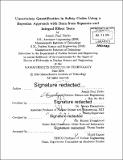Uncertainty quantification in safety codes using a Bayesian approach with data from separate and integral effect tests
Author(s)
Yurko, Joseph Paul
DownloadFull printable version (29.63Mb)
Other Contributors
Massachusetts Institute of Technology. Department of Nuclear Science and Engineering.
Advisor
Jacopo Buongiorno.
Terms of use
Metadata
Show full item recordAbstract
Uncertainty quantification in thermal-hydraulic safety codes is a very challenging and computationally expensive endeavor. Methods are therefore needed to reduce that computational burden, while still providing a reasonable estimate for uncertainty. To do so, a Quantitative Phenomena Identification and Ranking Table (QPIRT) is implemented to screen down to key parameters that influence a figure of merit. From there, a surrogate model is built to approximate the complex input-output relationship of the safety code. The surrogate model type chosen is that of a probabilistic response surface following the Gaussian Process (GP) model framework. A GP prior is placed on the input/output functional relationship, which ultimately leads to a Bayesian non-parametric non-linear model of the safety code. The surrogate emulates the behavior of the long running computer code and thanks to the GP, provides a simple estimate to the additional uncertainty in making a prediction. In addition, for emulating multiple outputs together, which is difficult to do with standard GP models, Gaussian Process Factor Analysis (GPFA) models also known as Function Factorization with Gaussian Process Priors (FFGP) models were applied. The FFGP models are far more complicated than the standard GP model and so various simplifying approximations were made to enable fast yet accurate emulation of the safety code. All together a suite of surrogate models with varying levels of complexity and thus flexibility were developed for emulating the complex response from a safety code. These very computationally cheap surrogates are then used to propagate the uncertainty in the key parameters onto the FOM. Information from previous Separate and Integral Effect Tests is then used to calibrate those key parameter distributions with Markov Chain Monte Carlo (MCMC). This allows the ultimate uncertainty of the figure of merit to be found conditioned on the knowledge gained from those past experiments.
Description
Thesis: Ph. D., Massachusetts Institute of Technology, Department of Nuclear Science and Engineering, 2014. Cataloged from PDF version of thesis. Includes bibliographical references (pages 359-366).
Date issued
2014Department
Massachusetts Institute of Technology. Department of Nuclear Science and EngineeringPublisher
Massachusetts Institute of Technology
Keywords
Nuclear Science and Engineering.